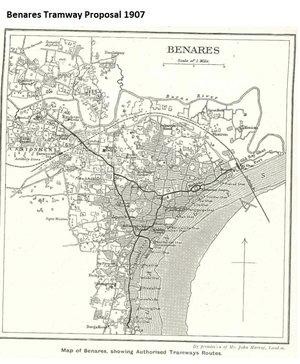Benares Tramway
Benares Tramway
The records show that there were two proposals put forward in 1886 and 1907 to construct a tramway system at Benares.
Neither of these proposals were adopted.
Benares Tramway, 1886 Proposal
The Benares Tramway Company was formed in 1886 as given in ‘Grace’s Guide’ [1] quoting ‘The Engineer’ 23 July 1886 page 81 ‘New Companies’ with transcript as follows:-[2].
'Benares Tramway Company Limited'
This company was registered on the 8th inst (8 July 1886), with a capital of £100,000 in £10 shares, to aquire the benefit of a concession from the Municipal Board of Benares, and approved by the Indian Government, for the construction and working of tramways in Benares. The company will adopt an agreement of the 7th inst. between S.H.Robinson of the one part, and F.W.Haddon (for the company) of the other part, and will also enter into agreements with George Pearson and Weetman Dickinson Pearson and with Walter Wood. Particulars of these agreements are not given in the memorandum and articles of association.
The subscribers are:- (one share each)
- Walter Wood, 13 Delhay Street S.W., engineer.
- S.Wright, 2 Manor Road, Bradford, solicitor.
- W.D.Pearson, 4 Durham Place, Kensington, contractor.
- S.B.Lawrence, 155 Grove Lane, S.E., secretary
- G.E.Arnold, C.E., 12 Harley Road S.E.
- W.H.Churchward, C.E., 10 Kingswood Villas, New Brompton.
- D.T.Fender, 2 Trafalgar Road, Twickenham.
The number of directors is not less than three nor more than twelve; qualification, shares or stock in the company, but any director may act before acquiring such qualification. The first directors are :-
- Lieut.-General G.G.Anderson
- J.Brunton, C.E.
- J Walrond Clarke
- Lieut.-General T.N.Harwood
- Lieut.-General J.L.Vaughan C.B.
The company in general meeting will determined remuneration. The directors may appoint one of their number to the position of managing director, and may determine his remuneration.
From “Indian Engineering” 15 Jan 1887:-
‘We understand that a London company have received a concession to lay a system of Tramways in Benares. The work will be carried out by a Calcutta firm. A hitch has occurred in the arrangements owing to the Municipality wishing to impose some impractical conditions. The system will comprise three lines; one from Raj Ghat to Cantonments, another from Cantonments to the Purana Chowk, and the third parallel to the city.” [3].
No further information concerning the 'Benares Tramway Company' has been found. It can only be presumed that the ‘impractical conditions’ being laid down by the Municipal Board of Benares caused the proposal to be abandoned.
There is no evidence that this tramway was constructed.
Benares Tramway, 1907 Proposal
The proposal was for 9.5miles (10.5km) of track with a power station producing 1200Kw/h. The tramway being powered at 550 volts.
There was a requirement for there to be no street wires, so a system developed by Mr. Robert Brown of The Traction Corporation ltd. Westminster, England.
The system was a switch and stud system, which is still in use today, the most famous is a section of the Bordeaux tramway in a UNESCO Heritage area. The circuit is only completed by the tramcar, any person standing on the stud and rail will find that it is electrically dead. The feed cable is buried beside or between the tracks.
The map published in 1907 shows the route with a triangle of lines in the centre of the town. The double line diverged at Macadri going either side of the of the Komeswar Temple.
There were to be 24 motor cars and 8 trailers to provide a 7 minute headway on all lines.
The report states that an order was placed but it may not have been built either because of trouble with the studs or the authorities fear of electrified studs in the road.
The map and schematics were published in "Tramway and Railway World" Vol XXII Nov 1907. The map and text is reproduced by permission of the Archivist, The National Tramway Museum, Crich, Derbyshire, England. The schematics are not reproduced in this article [4].
There is no evidence that this tramway was constructed.
References
- ↑ "Grace’s Guide"; Retrieved 29 Dec 2016
- ↑ "Grace’s Guide/The Engineer" 23 July 1886 page 81; Retrieved 29 Dec 2016
- ↑ "Indian Engineering" 15 January 1887 page 27; Retrieved 29 Dec 2016
- ↑ "Tramway and Railway World" Vol XXII Nov 1907. The map and text is reproduced by permission of the Archivist, The National Tramway Museum, Crich, Derbyshire, England
